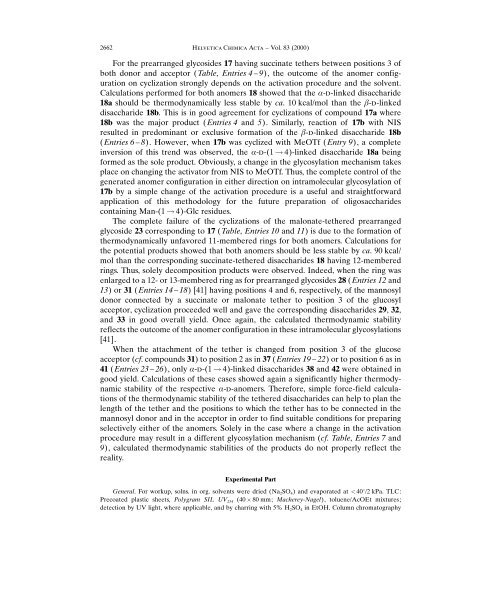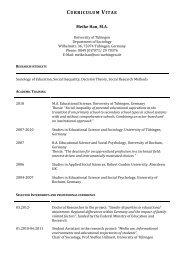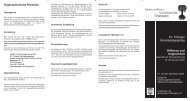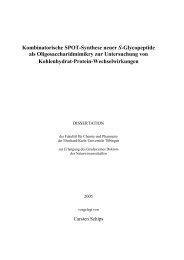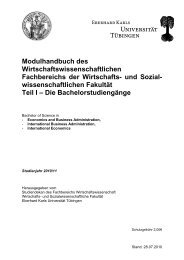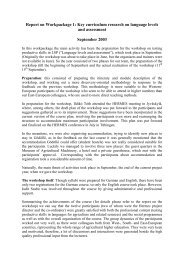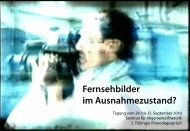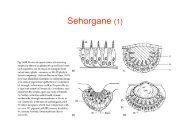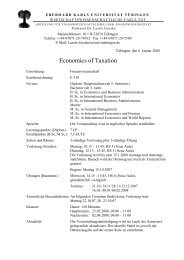2662 Helvetica Chimica Acta ± Vol. 83 2000) For the prearranged glycosides 17 having succinate tethers between positions 3 <strong>of</strong> both donor and acceptor Table, Entries 4 ± 9), the outcome <strong>of</strong> the anomer configuration on cyclization strongly depends on the activation procedure and the solvent. Calculations performed for both anomers 18 showed that the a-d-linked disaccharide 18a should be thermodynamically less stable by ca. 10 kcal/mol than the b-d-linked disaccharide 18b. This is in good agreement for cyclizations <strong>of</strong> compound 17a where 18b was the major product Entries 4 and 5). Similarly, reaction <strong>of</strong> 17b with NIS resulted in predominant or exclusive formation <strong>of</strong> the b-d-linked disaccharide 18b Entries 6 ± 8). However, when 17b was cyclized with MeOTf Entry9), a complete inversion <strong>of</strong> this trend was observed, the a-d-1 ! 4)-linked disaccharide 18a being formed as the sole product. Obviously, a change in the glycosylation mechanism takes place on changing the activator from NIS to MeOTf. Thus, the complete control <strong>of</strong> the generated anomer configuration in either direction on intramolecular glycosylation <strong>of</strong> 17b by a simple change <strong>of</strong> the activation procedure is a useful and straightforward application <strong>of</strong> this methodology for the future preparation <strong>of</strong> oligosaccharides containing Man-1 ! 4)-Glc residues. The complete failure <strong>of</strong> the cyclizations <strong>of</strong> the malonate-tethered prearranged glycoside 23 corresponding to 17 Table, Entries 10 and 11) is due to the formation <strong>of</strong> thermodynamically unfavored 11-membered rings for both anomers. Calculations for the potential products showed that both anomers should be less stable by ca. 90 kcal/ mol than the corresponding succinate-tethered disaccharides 18 having <strong>12</strong>-membered rings. Thus, solely decomposition products were observed. Indeed, when the ring was enlarged to a <strong>12</strong>- or 13-membered ring as for prearranged glycosides 28 Entries <strong>12</strong> and 13) or31 Entries 14 ± 18) [41] having positions 4 and 6, respectively, <strong>of</strong> the mannosyl donor connected by a succinate or malonate tether to position 3 <strong>of</strong> the glucosyl acceptor, cyclization proceeded well and gave the corresponding disaccharides 29, 32, and 33 in good overall yield. Once again, the calculated thermodynamic stability reflects the outcome <strong>of</strong> the anomer configuration in these intramolecular glycosylations [41]. When the attachment <strong>of</strong> the tether is changed from position 3 <strong>of</strong> the glucose acceptor cf. compounds 31) to position 2 as in 37 Entries 19 ± 22) or to position 6 as in 41 Entries 23 ± 26), only a-d-1 ! 4)-linked disaccharides 38 and 42 were obtained in good yield. Calculations <strong>of</strong> these cases showed again a significantly higher thermodynamic stability <strong>of</strong> the respective a-d-anomers. Therefore, simple force-field calculations <strong>of</strong> the thermodynamic stability <strong>of</strong> the tethered disaccharides can help to plan the length <strong>of</strong> the tether and the positions to which the tether has to be connected in the mannosyl donor and in the acceptor in order to find suitable conditions for preparing selectively either <strong>of</strong> the anomers. Solely in the case where a change in the activation procedure may result in a different glycosylation mechanism cf. Table, Entries 7 and 9), calculated thermodynamic stabilities <strong>of</strong> the products do not properly reflect the reality. Experimental <strong>Part</strong> General. For workup, solns. in org. solvents were dried Na2SO4) and evaporated at < 408/2 kPa. TLC: Precoated plastic sheets, Polygram SIL UV254 40 80 mm; Macherey-Nagel), toluene/AcOEt mixtures; detection by UV light, where applicable, and by charring with 5% H2SO4 in EtOH. Column chromatography
Helvetica Chimica Acta ± Vol. 83 2000) 2663 CC): silica gel 60 Macherey-Nagel), toluene/AcOEt mixtures. [a] D:at258; Perkin-Elmer-241 automatic polarimeter. NMR Spectra: CDCl 3 solns. at 258; Bruker-AC-300F and -DRX-500 spectrometers; at 300 and 500 MHz for 1 H, and at 75and <strong>12</strong>6 MHz for 13 C; 1 H assignments by first-order analysis and by H,H-COSY; 13 C assignments by mutual comparison <strong>of</strong> the spectra, by DEPT, and by C,H-COSY; d in ppm rel. to Me 4Si as internal standard, J in Hz; for prearranged glycosides and disaccharides, unprimed locants refer to the glucose and primed ones to the mannose moiety. Phenyl 3,4,6-Tri-O-benzyl-2-O-3-carboxypropanoyl)-1-thio-a-d-mannopyranoside 2a). A soln. <strong>of</strong> phenyl 3,4,6-tri-O-benzyl-1-thio-a-d-mannopyranoside 1a) [43] [44] 4.62 g, 8.51 mmol), succinic anhydride 6.81 g, 68.08 mmol), and a cat. amount <strong>of</strong> DMAP in pyridine 40 ml) was stirred for 24 h at 608, then cooled to r.t., diluted with CH 2Cl 2, and washed with aq. HCl and NaHCO 3 soln. Evaporation afforded crude 2a 4.84 g, 89%), which was used without further purification in the next step. Ethyl 3,4,6-Tri-O-benzyl-2-O-3-carboxypropanoyl)-1-thio-a-d-mannopyranoside 2b). As described for 2a, with ethyl 3,4,6-tri-O-benzyl-1-thio-a-d-mannopyranoside 1b) [45] 0.93 g, 1.9 mmol), succinic anhydride 1.13 g, 11.3 mmol), DMAP, and pyridine 50 ml) 24 h at r.t.): 2b 1.10 g, 98%). [a] D ˆ‡75.2 c ˆ 1.1, CHCl 3). 1 H-NMR CDCl3): 5.43 dd, J1,2) ˆ 1.3, J2,3) ˆ 2.5, H C2)); 5.30 d, J1,2) ˆ 1.3, H C1)); 4.13 ddd, J4,5) ˆ 8.4, J5,6a) ˆ 2.0, J5,6b) ˆ 4.4, H C5)); 3.91 ± 3.88 m, H C3), H C4)); 3.82 dd, J6a,6b) ˆ 10.8, H a C6)); 3.68 dd, H b C6)); 2.69 ± 2.55 m, CH 2CH 2COOH, SCH 2); 1.27 t, Me). 13 C-NMR CDCl3): 176.6, 171.4 CO); 82.3 C1)); 78.5C3)); 75.2 PhCH 2); 74.5C4)); 73.4 PhCH 2); 71.73 PhCH 2); 71.68 C5)); 71.0 C2)); 68.8 C6)); 29.5, 29.1 COCH 2CH 2); 25.6 CH 2S); 14.9 Me). Anal. calc. for C 33H 38O 8S 594.72): C 66.56, H 6.44, S 5.39; found: C 66.56, H 6.58, S 5.09. Benzyl 2-O-Benzoyl-4,6-O-benzylidene-3-O-[1,4-dioxo-4-phenyl 3,4,6-tri-O-benzyl-1-thio-a-d-mannopyranosid-2-O-yl)butyl]-a-d-glucopyranoside 4a). A soln. <strong>of</strong> 2a 4.69 g, 7.30 mmol), 3 [26] 3.75g, 8.11 mmol), DCC 1.67 g, 8.11 mmol), and a cat. amount <strong>of</strong> DMAP in CH 2Cl 2 50 ml) was stirred for 24 h at r.t. The resulting suspension was filtered through a layer <strong>of</strong> Celite, and the filtrate was washed with aq. HCl and NaHCO 3 soln., dried, and evaporated. CC toluene/AcOEt 20 :1) <strong>of</strong> the residue afforded 4a 4.55 g, 57%). [a] D ˆ‡103.7 c ˆ 0.8, CHCl 3). 1 H-NMR CDCl 3): 5.90 t, J3,4) ˆ 9.9, H C3)); 5.52 ± 5.48 m, H C1'), H C2')); 5.51 s, PhCH); 5.30 s, H C1)); 5.10 dd, J2,3) ˆ 9.9, H C2)); 4.86 t, J ˆ 10.8, 1 H, PhCH 2); 4.78 d, J ˆ <strong>12</strong>.4, 1 H, PhCH 2); 4.63 d, J ˆ <strong>12</strong>.0, 1 H, PhCH 2); 4.58 d, J ˆ 11.1, 1 H, PhCH 2); 4.57 d, J ˆ <strong>12</strong>.4, 1 H, PhCH 2); 4.48 d, J ˆ 10.7, 1 H, PhCH 2); 4.47 s, 1 H, PhCH 2); 4.45d, J ˆ <strong>12</strong>.2, 1 H, PhCH 2); 4.35± 4.32 m, J5',6a') ˆ 4.8, H C5')); 4.28 dd, J6a,6b) ˆ 10.1, H a C6)); 4.09 dt, J5,6a) ˆ 4.8, J5,6b) ˆ 9.9, H C5)); 3.92 ± 3.88 m, H C3'), H C4')); 3.83 dd, J6a',6b') ˆ 10.8, H a C6')); 3.74 t, H b C6)); 3.70 dd, H b C6')); 2.69 ± 2.52 m, COCH 2CH 2CO). 13 C-NMR CDCl 3): 171.2, 171.0 COCH 2CH 2CO); 165.8 PhCO); 101.6 PhCH); 95.9 C1)); 85.9 C1')); 79.1 C4)); 78.4 C3')); 75.2 PhCH 2); 74.5C4')); 73.3 PhCH 2); 72.4 C5')); 72.2 C2)); 71.7 PhCH 2); 70.5C2')); 70.0 PhCH 2); 69.2 C3)); 68.8 C6)); 64.0 C6')); 62.8 C5)); 29.0 2 C, COCH 2CH 2CO). Anal. calc. for C 64H 62O 14S 1087.25): C 70.70, H 5.75, S 2.95; found: C 70.50, H 5.76, S 2.97. Benzyl 2-O-Benzoyl-4,6-O-benzylidene-3-O-[4-ethyl 3,4,6-tri-O-benzyl-1-thio-a-d-mannopyranosid-2-Oyl)-1,4-dioxobutyl]-a-d-glucopyranoside 4b). As described for 4a, with 2b 1.1 g, 1.9 mmol), 3 [26] 0.86 g, 1.9 mmol), DCC 2.06 g, 2.0 mmol), 1-hydroxy-1H-benzotriazole <strong>12</strong>6 mg, 0.93 mmol), DMAP, and CH 2Cl 2 50 ml): 4b 1.16 g, 60%). [a] D ˆ‡88.4 c ˆ 1.0, CHCl 3). 1 H-NMR CDCl 3): 5.93 t, J3,4) ˆ 9.8, H C3)); 5.31 ± 5.25 m, H C1'), H C2')); 5.50 s, PhCH); 5.29 d, J1,2) ˆ 3.8, H C1)); 5.11 dd, J2,3) ˆ 10.0, H C2)); 4.80 d, J ˆ 10.5, 1 H, PhCH 2); 4.76 d, J ˆ 11.4, 1 H, PhCH 2); 4.63 d, J ˆ <strong>12</strong>.2, 1 H, PhCH 2); 4.55 d, J ˆ <strong>12</strong>.2, 1 H, PhCH 2); 4.51 d, J ˆ 11.0, 1 H, PhCH 2); 4.45d, J ˆ <strong>12</strong>.1, 1 H, PhCH 2); 4.50 s, 1H, PhCH 2); 4.42 d, J ˆ 11.4, 1 H, PhCH 2); 4.37 d, J ˆ 11.2, 1 H, PhCH 2); 4.13 ± 4.03 m, H C5), H C5')); 4.30 dd, J5,6a) ˆ 4.8, J6a,6b) ˆ 10.2, H a C6)); 4.13 ± 4.03 m, H C3'), H C4), H C4'), H b C6), H a C6')); 3.67 dd, H b C6')); 2.69 ± 2.50 m, 6 H, CH 2); 1.25t, Me). 13 C-NMR CDCl 3): 171.3, 171.1 COCH 2CH 2CO); 165.8 PhCO); 101.6 PhCH); 96.0 C1)); 82.3 C1')); 79.2 C4)); 78.5C3')); 75.1 PhCH 2); 74.5C4')); 73.3 PhCH 2); 72.3 C2)); 71.8 C5')); 71.6 PhCH 2); 70.7 C2')); 70.1 PhCH 2); 70.0 C6)); 69.2 C3)); 68.9 C6')); 62.9 C5)); 29.4, 25.4, 20.0 CH 2); 14.9 Me). Anal. calc. for C 60H 62O 14S 1039.20): C 69.35, H 6.01; found: C 69.14, H 6.04. Benzyl 2-O-Benzoyl-6-O-benzyl-3-O-[1,4-dioxo-4-phenyl 3,4,6-tri-O-benzyl-1-thio-a-d-mannopyranosid- 2-O-yl)butyl]-a-d-glucopyranoside 5a). A sat. soln. <strong>of</strong> dry HCl in Et 2O was added dropwise at r.t. to a suspension <strong>of</strong> 4a 0.80 g, 0.78 mmol), NaCNBH 3 0.61 g, 9.75mmol) and 3-Š molecular sieves in THF 15ml) until the gas evolution ceased. The mixture was diluted with CH 2Cl 2 and filtered through a layer <strong>of</strong> Celite, and the filtrate was washed with aq. NaHCO 3 soln., dried, and evaporated. CC toluene/acetone 13 : 1) <strong>of</strong> the residue afforded 5b 0.63 g, 79%). [a] D ˆ‡27.6 c ˆ 0.7, CHCl 3). 1 H-NMR CDCl 3): 5.68 dd, J3,4) ˆ 9.2, H C3));


